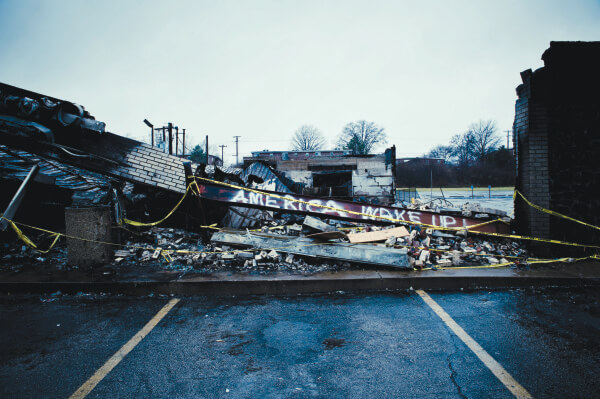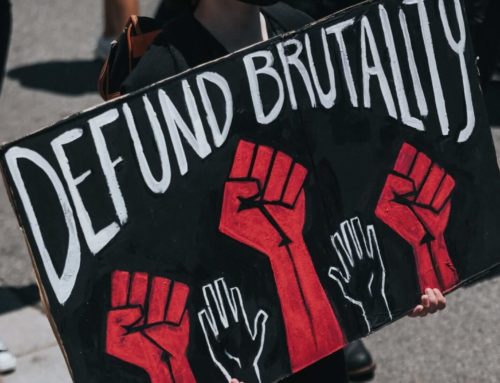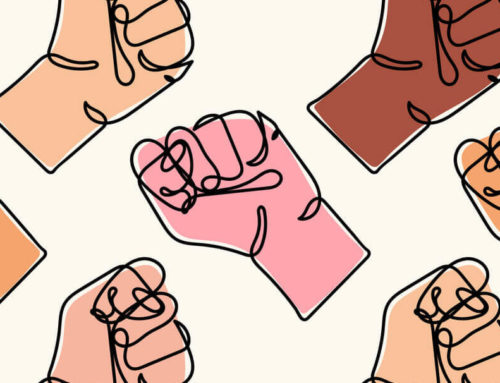Above: America Wake Up is scrawled on an I-beam in the burnt out rubble that once was Beauty Town. The store was burnt down during the protest on Nov. 24, 2014. Photo by Shawn Escoffery shawnescoffery.com & distantdreams.me
By William Cordery – March 17, 2016
Grassroots Fundraising Journal – editorial board
THE POLICE BRUTALITY AND IMPUNITY that led to the deaths of Tamir Rice, Michael Brown, Sandra Bland, Eric Garner, Freddie Gray, LaQuan McDonald, and countless others have once again highlighted the importance of community organizing for social and structural change. With growing national attention on the Movement for Black Lives, a conversation has surfaced across the field of philanthropy on its role in supporting this movement. Funders are asking themselves how best to meet immediate and urgent needs of communities under attack while also building long-term infrastructure for communities to respond in the future.
The Movement for Black Lives and Black Lives Matter have afforded philanthropy an opportunity to rethink how to be more helpful to communities in peril. Over the past few years, we’ve seen notable shifts in how donors and institutional funders move money to crises and burgeoning movements.
In 2012, the Solidaire network was established to organize donors to effectively respond to the sustainability needs of local protests connected to the Occupy Movement, as well as to deepen their analysis on vast income disparities. This network of individual donors has since broadened its frame to respond to social movements in a timely way, including worker justice, climate change, immigration, and anti-Black racism.
The uprisings in Ferguson and Baltimore were game changers for Solidaire. Last year, Solidaire moved more than $300,000 to rapid response support of the Movement for Black Lives, distributing funds directly to groups in Ferguson, Baltimore, Minneapolis, and Chicago. Since officially launching in 2013, Solidaire has moved more than a half million dollars to movement building organizing, much of which went to local and state campaigns that traditional funders would not touch. It became clear to Solidaire members that standard philanthropic mechanisms to move resources in a timely and expedient way was best done by connecting conscious individuals with wealth to local community campaigns.
Last year, Resource Generation (RG)—an organization devoted to organizing young people with wealth and class privilege to utilize their resources for transformative and equitable shifts in power—successfully challenged itself and its members to deploy more than $1 million in just nine months to support Black-led organizing for Black liberation after the death of Michael Brown. RG members were guided by a collective understanding that racialized violence and wealth accumulation are inextricably linked, and that wealthy people have a responsibility to counter this with their resources and platform. Equally important, RG members who made contributions also committed to a long-term process of combating anti-Black racism, following the leadership of those in directly-impacted communities, and leveraging their family and personal networks to support change.
RG members provided direct contributions for general operating funds to groups like the BlackOut Collective, the New Jim Crow Movement, and We Can’t Breathe Political Action Committee, while forging meaningful relationships with their leadership and work.
North Star Fund also launched an initiative that moved individual donor funds directly and immediately to community groups to respond to police abuse in Black and marginalized communities. The Let Us Breathe Fund focused on New York City and distributed more than $280,000 between April and September 2015.

Women Donors Network, a network of women philanthropists committed to collectively moving monetary and human capital to support progressive change, also joined the pledge to raise more than $1 million for racial justice in the wake of the deaths of Mike Brown and Eric Garner. Resource Generation Executive Director Jessie Spector shares, “Individual donors can and do move so much faster and can be more nimble than foundations…this has become a call to action
Institutional philanthropic organizations have begun to heed the call. Several funder tables have emerged to support the Movement for Black Lives, aiming to minimize the red tape and organizational muck that sometimes prohibit foundations from responding quickly to timely crises or social movements. Most of these funds rely on trusted movement leadership to keep their collective ear to the ground and to deploy the right amount of resources at the right time. Some of these funds have very simple application processes that can move the funds within a matter of days, rather than the weeks or months it usually takes. These funds include the following:
■ Neighborhood Funders Group’s Funders for Justice. This table is committed to organizing funders and affinity groups around issues of racial justice and police brutality, while helping foundations more effectively respond to crises and invest in long-term social movement infrastructure.
■ Hill Snowdon Foundation’s Making Black Lives Matter Initiative. This is a three-year grantmaking and co-funding initiative focused on deploying $900,000 in grants to Black-led organizations building power in Black communities through policy change, organizational infrastructure,public discourse, and leverage.
■ Third Wave Fund’s Mobilize Power Fund. This organization has moved rapid response dollars to support campaigns like Black Youth Project 100’s #SayHerName Campaign, BreakOUT!’s Trans March of Resilience (a demonstration for justice and equality for trans people of color), and GetEQUAL’s #YearWithoutTamir Weekend of Action in Tamir Rice’s hometown of Cleveland.
■ Headwaters Foundation for Justice’s Emergency Fund for Black Lives. Launched this past December, the foundation committed to moving $100,000 to support the work of Black Lives Matter Minneapolis and Neighborhoods Organizing for Change (NOC), two local groups leading demonstrations after the police killing of Jamar Clark, as well as community healing work after protestors were attacked and shot by white supremacists.
“When there’s trust, resources move more quickly and will likely be used more effectively, because people can be real about what they really need. [Then], giving is not directly tied to outcomes. It is tied to investment in the work.”
~Alicia Garza
Despite the bold efforts of donors and foundations to invest in the Movement for Black Lives, the majority of financial resources for community organizing still comes directly from the impacted communities themselves. Last December, the Los Angeles chapter of Black Lives Matter launched a social media campaign to raise money for legal support after members were detained during “Black Christmas” demonstrations. They have raised tens of thousands of dollars through online portals such as Crowdwise and Color of Change. Black Lives Matter chapters in Chicago and Minneapolis have also run crowdfunding campaigns after violent retaliations (by both police and vigilantes) toward demonstrators.
According to Alicia Garza, co-founder of Black Lives Matter, one key distinction between social movements’ relationships to donors and institutional funders is trust. She explains, “When there’s trust, resources move more quickly and will likely be used more effectively, because people can be real about what they really need. [Then], giving is not directly tied to outcomes. It is tied to investment in the work.” With individual donors, organizations are in relationship in real time, which results in political trust being established far more quickly than with institutional philanthropy.
In July 2015, nearly 1,000 Black community organizers, movement leaders, and advocates traveled to Cleveland for a national Movement for Black Lives convening, designed to build shared consciousness, skills, and organizing strategy across all local communities that have been disparately working to counter anti-Black racism. The co-conveners for the meeting only had a handful of weeks to raise $400,000 to cover the costs of the meeting—securing funding from donor networks, organized labor, and foundations.
Imagine if institutional philanthropy strengthened its mutual trust with social movements by matching our grantmaking strategies with movement building principles.
The majority of the funding came primarily from small donations from individuals, though foundations like Ford, Mertz Gilmore, Nathan Cummings, Kellogg, Surdna, and Andrus Family Fund provided small discretionary grants to cover convening costs. Even with discretionary grants, these foundations showed that they understood the importance of Black community leadership having the space to strategize and build collective consciousness— and that this capacity building is directly connected to strengthening the work tied to our philanthropic institutions’ current missions and strategies for social justice.

Imagine if institutional philanthropy strengthened its mutual trust with social movements by matching our grantmaking strategies with movement building principles. Foundations could resource community organizing with long-term, general operating support so groups can have the flexibility to concentrate their efforts for structural change. If we understand movement building to consist of broad-based efforts to build power at the community level—often led by those most directly impacted by issues—as well as challenging power holders, institutions, and societal norms to fundamentally shift toward a new vision, then philanthropy needs to understand its place and its power in that space. This includes taking its cues directly from the organizers themselves.
The impact we’re trying to advance is far greater than our individual funding strategies, so our philanthropy should reflect that. We in philanthropy need to commit to funding racial justice work beyond the appeal of a social media hashtag or a national headline. This requires institutions and individuals in positions of power to build our collective consciousness on radicalized and economic violence and match our actions to that understanding.
William Cordery is a program officer for the Strong Local Economies program at Surdna Foundation, and serves on the Grassroots Fundraising Journal Editorial Board. Follow him on Twitter @WilliamCordery.
To support the Movement for Black Lives, please visit:
- Movement for Black Lives Convenings
- Black Lives Matter
- Black Youth Project 100
- Million Hoodies Movement for Justice
Read the original article in the Grassroots Fundraising Journal.



